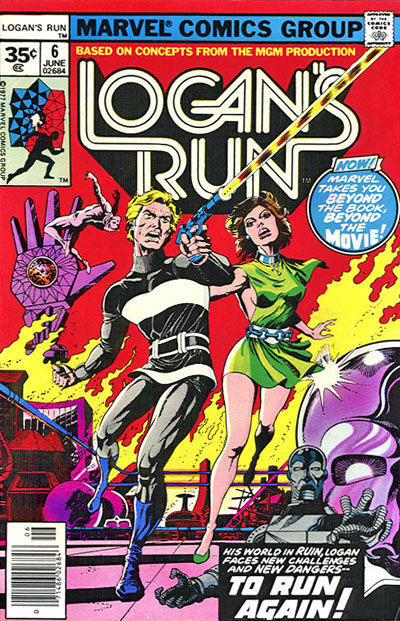Genre: Sci-Fi
Premise: In the future, every man and woman must voluntarily die the day they turn 30. But there are a few who refuse to do so. Instead, they run.
About: There may not be a project in Hollywood that’s been more developed than Logan’s Run. An untold number of drafts have been written over the years and many directors have attached themselves to the project only to eventually move on. The draft I’m reviewing today is special as it was co-written by my writing crush, Alex Garland. One day Logan’s Run will be made. The premise is tailor-designed for a 2 hour feature film. But which combination of creatives will finally get it across the finish line remains unknown. For the ones that do, they might want to use this version of the script as a guide.
Writers: Alex Garland and Michael Dougherty (based on the novel by William F. Nolan and George Clayton Johnson)
Details: 2010 draft
Yesterday’s post got me all nostalgic for long-running projects in development hell and one of the most famous of those unmade movies is Logan’s Run. The project seems to have been greenlit a dozen times in the past two decades, yet it always seems to fall apart.
However, I know it will get made eventually. How do I know that? Cause it’s got the ultimate GSU factor working for it, baby! Goal, get out of the city. Urgency, everyone’s trying to get you. Stakes, you fail you die.
The briefly conveyed backstory of Logan’s Run (by the way, if you’re writing a big sci-fi script, the more briefly you can convey your backstory, the better) is that there was a giant war, so an AI dude named Thinker was created to come up with the best way to keep mankind alive. He constructed a city called Eden where the only rule you had to follow was, when you turn 30, you have to die.
Our hero, Logan, is 29. Or somewhere around 29. Nobody quite knows what their age is. That information is given to them via a color-coded leaf tattoo on the inside of your hand. Your leaf starts at green and by the time it becomes all black, you have to go to the “Sleep Shop” where they terminate your too-old ass.
Logan is a sandman. That means he’s the police for people who try to run after their 30th birthday. He will hunt you down and kill you on sight. You don’t even get the dignity of going to Sleep Shop. Logan isn’t just good at his job. He’s the best, with more kills than any sandman in history.
But things become a little extra real for Logan when his good friend and fellow sandman, Cassie, gets her Sleep Shop marching orders. Logan accompanies her to her death, where he’s allowed to watch as she’s taken into a white room and put to sleep. The event has a heavy effect on Logan. He’s always been told how honorable and amazing volunteering for sleep is. But this felt anything but honorable.
Logan is then called to see Thinker, the “doesn’t even try to hide how evil he is” A.I. dictator of Eden. Thinker says he’s heard of this thing called Sanctuary that some runners escape to. He wants to find out where this place is so he can stop it. Therefore, he artificially speeds up Logan’s hand leaf so his death day is…. TODAY. Uh, say what?? says Logan. You see, Thinker says, the best way to find Sanctuary is to become a runner. So Logan’s all of a sudden running for his life.
He eventually meets up with this chick named Penelope, who explains that she gives every runner a chance, even evil sandmen like himself. “Everyone deserves a shot at Sanctuary” is the underground rule. After lots of evading, Penelope leads them back to Sleep Shop, where you must sneak out of the city with all the dead bodies. Out past the mountains of dead people is where they will find Sanctuary. Or will they?
Last week I highlighted an early scene in Street Rat Allie Punches Her Ticket that leaned into the emotional connection of the characters. The reason I did that is to remind you that even when you’re writing a script that might seem like it’s surface-level summer fare, you still need to write scenes – especially early on – that emotionally connect us to the characters and the situation.
Here we get that scene when Logan accompanies Cassie to Sleep Shop. These two have been told their whole lives what an honor this moment is for the human experience. And yet, when they go through it, it’s anything but. It’s cold. It’s cruel. It’s empty. It’s terrifying. I loved how Garland and Dougherty chronicled every second of it.
Weak action writers shy away from moments like this. They want to get them over with as soon as possible because they feel like they’re betraying what the audience came for. “If the audience comes for a big fun action movie, we can’t give them a sad death scene,” is their fear. “They’ll be pissed off.” But these are the scenes that do the best job of connecting us with the characters early on so that we’re emotionally connected with them throughout the rest of the story.
Another thing I want to bring up is irony.
If there’s one thing where you can clearly recognize, as a reader, that the writer is NOT beginner level, it’s when they incorporate irony in a major way. Let’s say you’re writing Logan’s Run. Everything about your script is the same as it is here. The only difference is you haven’t decided who your main character is yet. They’re a blank slate.
You could’ve easily made Logan a street vendor. You could’ve made him a doctor. You could’ve made him a prominent businessman. And most writers in this situation would pick one of those jobs. I know that because I read all those scripts where they did pick those jobs.
That’s not to say these are bad choices.
But, by making Logan a policeman who specifically chases runners, it means that basing the movie around him becoming a runner himself is ironic. It adds more pop to the story. And where it really helps you is in the logline. Everybody loves a well-crafted ironic concept. A man with a major speech impediment must give the most important speech in history (The King’s Speech). So whenever I see that, it’s a good sign that I’m going to read a solid script.
Here’s the thing with these movies, though. You can’t have 90 minutes of running around. I mean, you could. But you’d be shocked at how quickly action becomes boring when you give us one action scene after another after another after another. So when you’re writing this kind of script (a ‘running away from the bad guys’ script) you want to structure the second act so that the ‘running’ set pieces are spread out. Between those running set pieces, you need planning and execution scenes. Those will actually take up the majority of your screen time.
A great movie where you can study this is The Fugitive. But Garland and Dougherty do a good job also. You’ve got Logan and Penelope, and they have to plan some objective (they need to find a guy who can help them, for example). The planning phase is figuring out where he might be and how they’re going to get in contact with them. Then they have to go try and do it. This is the execution part. And, of course, when they do it, something will go wrong, and they’ll be chased. But it’s really the planning and the execution that take up most of the screen time.
Some writers might be scared of that. I NEED TO GIVE THEM ACTION, CARSON! THIS IS AN ACTION MOVIE. Let me ask you this. What’s more enjoyable? The lead up to the roller coaster ride or the roller coaster ride itself? I’d say the anticipation of getting on the roller coaster is pretty darn exciting. That’s what you’re doing with your plan and execution scenes. You’re making the reader wait in line for the ride. They’re not going to be bored if they know there’s a ride at the end.
I didn’t have many issues with this script. The biggest mark against it is that it feels familiar. We’ve seen this format before. Oblivion did it. And I’m sure you guys can think of a dozen other movies with similar plots in the comments. So while the execution was good, it was working within a trope-heavy format that limited just how fresh and cool it could be. I mean, let’s be honest. This is a 50-year-old story.
Despite that, I found it to be really fun. And Alex Garland continues to be one of the most impressive writers around. This was such an easy read. 125 pages read like 95. His writing is so clear and unobtrusive. It’s designed to never have you stop and read a line twice. I love it. The crush remains.
Check this one out. Good stuff!
[ ] What the hell did I just read?
[ ] wasn’t for me
[xx] worth the read
[ ] impressive
[ ] genius
What I learned: Two things you can play with that create really solid movie ideas are TIME and SPACE. When you limit those two things, it organically sets up a scenario that is easy for the audience to understand. Time here = 30 years. You have to run before you hit 30. SPACE is this contained city. It’s got walls. It’s got barriers. So it’s very easy for us to understand what the objective is. Logan needs to get out of the city. If your concept feels murky or unclear, use time and space to make it clearer.



